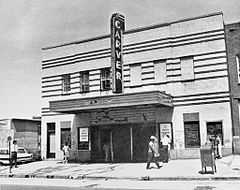John Jacob Zink
John Jacob Zink (1886-1952) was an American architect who designed movie houses in Washington, D.C., and Baltimore.
Life
He studied at the Maryland Institute, and practiced with Wyatt and Nolting. He studied at the Columbia School of Architecture. He worked with architect Thomas W. Lamb. He worked for Ewald G. Blanke, a famous Baltimore architect from 1916-1924. Their firm of Blanke and Zinc was located at 835 Equitable Building in Baltimore City.
In the early 1920s, he started his own design firm. He was a Streamline Moderne architect. Employing modest designs, he concentrated on details, such as views, lighting and acoustics. He incorporated such amenities as nurseries, lounges and smoking rooms.[1]
Works

Carver Theater just before it opened as the Anacostia Community Museum, 1967
- 1936 Uptown Theater
- 1937 Newton Theater
- 1938 Atlas Theater and Shops
- 1939 Senator Theatre, Baltimore
- 1939 Congress Theater
- 1940 Apex Theater
- 1940 Village Theater
- 1942 Senator Theater, Washington, D.C.
- 1945 Langston Theater
- 1945 Commodore Theater, Portsmouth, Virginia[4]
- 1946 Naylor Theater [5]
- 1948 Carver Theater, Anacostia, Washington, D.C.[6]
- 1950 Flower Theatre, Silver Spring, Maryland[7][8]
- 1952 Langley Theatre, Langley Park, Maryland [9]
References
- ↑ Building History
- ↑ Takoma Theatre Conservancy - Theatre Building
- ↑ Takoma Theatre in Washington, DC - Cinema Treasures
- ↑ History by the Commodore Theatre - Portsmouth, VA
- ↑ Naylor Theatre in Washington, DC - Cinema Treasures
- ↑ "Carver Theatre". Anacostia. Cinema Treasures. Retrieved 21 April 2012.
- ↑ Flower Theatre in Silver Spring, MD - Cinema Treasures
- ↑ Inside Movies Since 1920
- ↑ Langley Theatre in Langley Park, MD - Cinema Treasures
External links
- "John J. Zink", Cinema Treasures
- John J. Zink, Architect, Takoma Theater